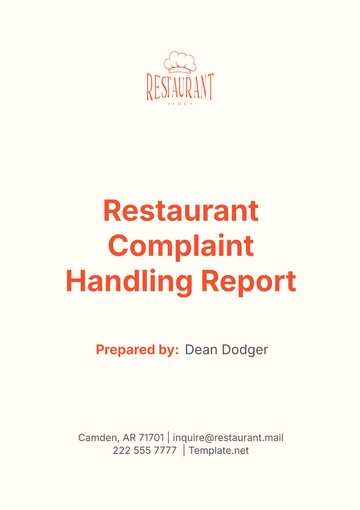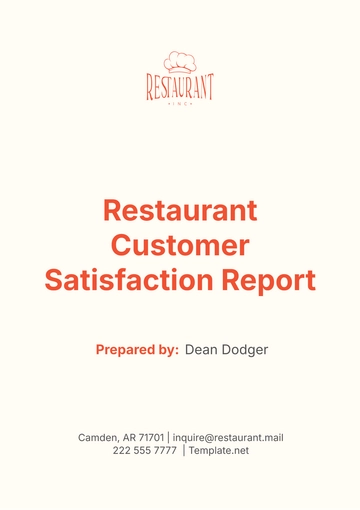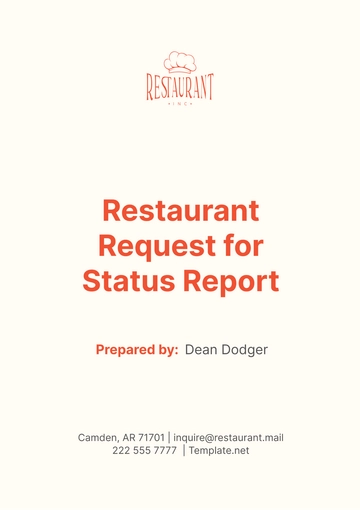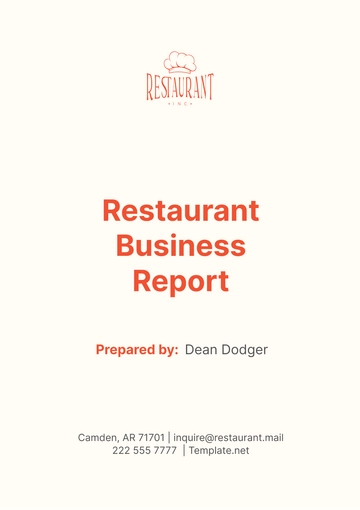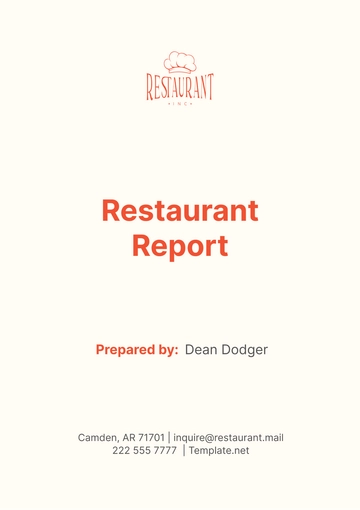Free Catering Report

I. Executive Summary
In the year 2050, [Your Company Name] delivered exceptional catering services to a diverse range of clients, showcasing our commitment to quality, innovation, and customer satisfaction. Our offerings included high-quality food and beverages, custom-tailored menus, and outstanding service at multiple events, all designed to meet the unique needs of our clients. This report outlines the various aspects of our catering operations, including service delivery, customer feedback, financial analysis, and strategic recommendations for further improvement. By examining our successes and challenges, we aim to create a roadmap for sustainable growth in the coming years.
Throughout the fiscal year, [Your Company Name] catered for over [200] events, ranging from corporate gatherings, weddings, and private parties to large-scale conferences. The average attendance at each event was approximately [150] people, reflecting the growing demand for our services in a recovering economy. We generated a total revenue of [$1,000,000] during this period, with an average event cost of [$5,000]. The growth in our catering division can be attributed to a focus on sustainability, local sourcing, and an emphasis on customer satisfaction.
The report below is divided into various sections, each providing a detailed insight into our operations and future strategies. We will discuss our various event types, menu offerings, financial performance, customer feedback, challenges faced, and strategic recommendations that will ensure our continued success.
II. Catering Services Overview
A. Types of Events Catered
[Your Company Name] catered a wide range of events during 2050, focusing on various event types that required distinct levels of service and customization. The events catered are broken down as follows:
1. Corporate Events
Corporate catering remained a core offering of our services, providing a robust revenue stream and establishing valuable relationships with businesses in our community. We provided meals, snacks, and beverages for corporate meetings, conferences, and retreats. [Your Company Name] catered for [50] corporate events, serving an average of [100] employees per event. These events ranged from breakfast meetings to elaborate corporate galas, and we ensured that our menus were flexible and adaptable to suit the formal or informal nature of each gathering. The corporate menu was tailored to client preferences and dietary requirements, including vegan, gluten-free, and allergy-conscious options.
Additionally, we recognized the importance of punctuality and efficiency for corporate clients. Our team excelled in setting up catering stations quickly, enabling our clients to focus on their events without worrying about the logistics of food service. This commitment to efficiency resulted in positive feedback from numerous corporate clients, many of whom expressed interest in repeat business for future events.
2. Weddings
Weddings accounted for a significant portion of our catering activities, contributing to nearly [30%] of the annual revenue. Our specialized wedding menus included customizable multi-course meals and beverage packages designed to cater to various tastes and preferences. A total of [60] weddings were catered, with guest counts ranging from [50] to [300] attendees. Our focus on personalized service, presentation, and high-quality ingredients ensured customer satisfaction in this category.
We took great pride in working closely with couples to create a menu that reflected their love story and shared experiences. From themed receptions to traditional ceremonies, our team meticulously planned every detail, ensuring that every couple felt valued and supported throughout the process. Additionally, our wedding coordinators helped couples navigate through logistical challenges, allowing them to enjoy their special day without added stress.
3. Private Parties
Private parties and social gatherings, including birthdays and anniversaries, made up about [20%] of the events catered. In total, [40] private parties were serviced, averaging [80] guests per event. Our offerings for these events were more informal and focused on finger foods, buffet setups, and creative beverages. We provided a variety of options ranging from hors d'oeuvres to full buffet spreads, ensuring that every guest had something to enjoy.
Our attention to detail was evident in how we designed these gatherings. We encouraged clients to select themes that would elevate the dining experience, such as summer barbecues or elegant cocktail parties. By personalizing menus and décor to match the event's theme, we created unforgettable experiences for our clients and their guests.
4. Conferences and Large-Scale Events
We catered to [20] large-scale conferences with attendee counts exceeding [500] people. These events required elaborate setups, including buffet stations, plated meals, and dedicated beverage counters, making effective planning and execution essential. Our team worked in close coordination with event planners to manage the logistics of these large gatherings, ensuring that every detail was accounted for, from food preparation to on-site service.
To handle the complexity of these events, we established clear communication channels with event organizers. This facilitated efficient decision-making and allowed us to respond to any unforeseen changes quickly. Our experience in managing large events contributed to a reputation for reliability, attracting more business in the conference and trade show sectors.
B. Menu Customization and Offerings
1. Dietary Restrictions
One of the highlights of [Your Company Name]’s service was our ability to accommodate various dietary restrictions, which have become increasingly important in today's health-conscious society. Over [70%] of the events we catered required special menus tailored to these restrictions. We took great care to ensure that our offerings included vegetarian, vegan, gluten-free, nut-free, and halal options, ensuring that all guests could enjoy the meals served.
To streamline the menu planning process for clients, we developed a clear categorization of dietary options, making it easier for clients to navigate their choices. We provided detailed descriptions of each dish, including ingredients and potential allergens, empowering clients to make informed decisions. This approach significantly enhanced our clients’ confidence in our services and helped us stand out in a competitive market.
2. Local and Sustainable Sourcing
As part of our commitment to sustainability, [Your Company Name] prioritized sourcing ingredients from local farms and suppliers. [80%] of our ingredients were locally sourced, ensuring freshness and reducing our carbon footprint. Sustainable sourcing also allowed us to emphasize seasonality, offering menus that aligned with the freshest available produce. By forming partnerships with local farmers, we ensured that our ingredients were of the highest quality while supporting the local economy.
Our commitment to sustainability extended beyond ingredient sourcing. We also implemented practices such as minimizing food waste through careful planning and utilizing composting for any leftover food. Clients appreciated our environmentally friendly practices, and many highlighted this commitment as a deciding factor in choosing our services over competitors.
3. Beverage Services
Our catering services also included a wide range of beverage packages, from non-alcoholic options to premium bar services. We offered coffee stations, tea setups, juice bars, and a selection of wines, beers, and cocktails tailored to client preferences. Beverage services contributed approximately [$100,000] in revenue, representing [10%] of our total catering income. We continuously updated our beverage offerings to include trendy options, such as craft beers and signature cocktails, appealing to a diverse clientele.
Our experienced bartenders were trained not only in mixology but also in customer service, ensuring that guests received a memorable experience. We provided options for both self-serve stations and full-service bar experiences, allowing clients to choose what best suited their event.
C. Service Delivery
1. On-Site Staff
For each event, [Your Company Name] provided a trained staff of waiters, chefs, bartenders, and service coordinators. Depending on the size of the event, we deployed between [10] and [50] staff members to ensure a seamless experience. Staff training focused on hospitality, food safety, and customer service excellence. The feedback from clients consistently highlighted the professionalism of our on-site teams, contributing to high satisfaction ratings across all event types.
We recognized the importance of ongoing training and development. Regular workshops were conducted to enhance staff skills, including food presentation, guest interaction, and crisis management. This investment in staff development not only improved service quality but also boosted employee morale and retention rates, further strengthening our team.
2. Equipment and Rentals
We offered a wide range of equipment rentals, including tables, chairs, linens, utensils, glassware, and kitchen equipment. For large-scale events, we also provided mobile kitchen setups. The rental of equipment accounted for an additional [$50,000] in revenue during 2050. We continuously updated our inventory to include trendy and modern items, allowing our clients to choose styles that matched their event themes.
Our logistics team was trained to handle all aspects of equipment setup and breakdown, ensuring that our clients did not have to worry about the logistics. This attention to detail was a significant advantage for our clients, allowing them to focus on other aspects of their events. By maintaining an extensive inventory and efficient processes, we were able to cater to a variety of client needs without compromising on quality or service.
III. Financial Analysis
A. Revenue Breakdown
Below is a breakdown of the revenue generated from our catering services in 2050, highlighting the strong performance across various event types:
Category | Number of Events | Revenue [$] | Percentage of Total Revenue [%] |
|---|---|---|---|
Corporate Events | [50] | [$250,000] | [25%] |
Weddings | [60] | [$400,000] | [40%] |
Private Parties | [40] | [$150,000] | [15%] |
Conferences/Events | [20] | [$200,000] | [20%] |
Total | [170] | [$1,000,000] | 100% |
This table illustrates the diversified nature of our catering business, demonstrating our ability to serve a variety of clients while minimizing dependency on any single segment. Each category has unique demands and requires distinct strategies, and our balanced approach has allowed us to maximize revenue opportunities across all types of events.
1. Profit Margins
Our gross profit margin for 2050 stood at approximately [30%]. This is largely due to the efficiencies in sourcing local ingredients, minimizing waste during event production, and optimizing labor costs through effective staff management. Our direct costs included food purchases, staff wages, transportation, and equipment maintenance.
By closely monitoring our expenses and continuously seeking cost-effective solutions, we have been able to sustain healthy profit margins while maintaining the quality of our services. The focus on local sourcing not only supported our sustainability goals but also helped us control costs by reducing transportation expenses.
B. Cost Analysis
The following table highlights the primary costs incurred during our catering operations, providing insights into areas where we can optimize spending:
Cost Category | Amount [$] | Percentage of Total Costs [%] |
|---|---|---|
Food & Beverage | [$350,000] | [50%] |
Staff Wages | [$200,000] | [28.5%] |
Equipment Rentals | [$50,000] | [7.1%] |
Transportation | [$20,000] | [2.9%] |
Marketing & Advertising | [$30,000] | [4.3%] |
Miscellaneous | [$50,000] | [7.2%] |
Total | [$700,000] | 100% |
The table above shows that food and beverage costs are the largest expense category, as expected in the catering industry. It is crucial to maintain relationships with our suppliers to secure competitive pricing without sacrificing quality. Staff wages represent a significant portion of our expenses, reflecting the importance of investing in our workforce to ensure high levels of service and client satisfaction.
IV. Customer Feedback and Satisfaction
A. Client Satisfaction Surveys
Customer satisfaction remained one of the top priorities for [Your Company Name]. Post-event surveys were sent to each client, gathering feedback on food quality, service, presentation, and overall experience. The average customer satisfaction rating was [4.8/5]. This strong performance was consistent across event types, indicating that our team was successfully meeting and often exceeding client expectations.
We actively encouraged clients to provide detailed feedback and suggestions for improvement. Our commitment to continuous improvement is evident in our willingness to adapt based on client insights. For instance, we adjusted our service styles and menu options in response to survey feedback, demonstrating our dedication to listening to our clients and evolving accordingly.
B. Key Feedback Themes
1. Food Quality and Presentation
Most clients praised the quality of the food and its presentation. Special commendations were received for the freshness of ingredients and the creative plating styles. Many clients highlighted that the use of locally sourced ingredients contributed to the high quality of the meals served. Our culinary team was consistently recognized for their innovation and creativity in crafting menus that reflected both seasonal availability and client preferences.
In addition to positive feedback, some clients offered suggestions for enhancing menu diversity. This valuable input has prompted us to consider introducing more ethnic cuisines and fusion dishes in our offerings, reflecting the growing demand for unique culinary experiences.
2. Service Excellence
The professionalism and efficiency of the on-site staff were consistently mentioned in the feedback. Clients appreciated the staff’s attention to detail, punctuality, and flexibility in handling last-minute requests or changes. Many commented on the friendly demeanor of our team, which contributed to a welcoming atmosphere at events. This aspect of our service was not only integral to the success of the events but also played a significant role in building lasting client relationships.
Recognizing the importance of staff performance in the overall client experience, we will continue to prioritize staff training and development to maintain our high service standards.
3. Areas for Improvement
Though feedback was overwhelmingly positive, a few areas for improvement were identified. Some clients suggested expanding our dessert offerings, particularly to include more gourmet options and innovative flavors. Additionally, there were requests for more options for beverage customization, particularly regarding unique cocktails and craft beverages.
We have taken this feedback into account and plan to implement more diverse dessert and beverage menus in 2051. By addressing these areas for improvement, we aim to enhance the overall experience for our clients, ultimately leading to increased satisfaction and repeat business.
V. Challenges Faced
A. Supply Chain Disruptions
One of the key challenges faced in 2050 was the disruption of the supply chain due to environmental factors. Weather anomalies in certain regions affected the availability of some seasonal ingredients, which in turn impacted our ability to deliver specific menu items. This caused minor delays in some events, as we had to find alternative suppliers or adjust menus on short notice.
To mitigate this issue in the future, we are actively exploring relationships with multiple suppliers for critical ingredients. This strategy will enable us to maintain flexibility and ensure that we can continue to deliver high-quality meals regardless of unforeseen circumstances.
B. Labor Shortages
The catering industry faced significant labor shortages, which impacted the availability of temporary staff for large events. As the demand for catering services grew, so too did the competition for skilled labor. [Your Company Name] addressed this by developing a stronger pool of part-time and freelance workers, but the shortage did increase wage costs and affected scheduling efficiency.
To attract and retain quality staff, we implemented competitive compensation packages and flexible scheduling. Furthermore, we are exploring partnerships with local culinary schools to create internship opportunities that can lead to permanent employment, helping to build a reliable workforce for the future.
C. Rising Costs
Rising costs, particularly for transportation and certain imported ingredients, put pressure on our profit margins. These cost increases were largely due to global economic trends, including fuel price hikes and supply chain interruptions. To counter these rising expenses, we are focusing on maximizing efficiencies within our operations, including reducing waste and optimizing logistics.
Additionally, we are continuously reviewing our pricing strategies to ensure that our offerings remain competitive while maintaining the quality that our clients expect. Through careful analysis and strategic planning, we aim to navigate these challenges effectively.
VI. Strategic Recommendations
A. Expand Menu Offerings
Based on customer feedback and market trends, [Your Company Name] will expand its dessert and beverage offerings in 2051. This will include more gourmet dessert options, such as artisanal cakes, unique pastries, and seasonal fruit tarts, as well as innovative beverage selections that highlight craft cocktails and local wines. Diversifying our menu will allow us to cater to an even wider range of clients and provide more personalized experiences.
Additionally, we will conduct market research to identify trending food items and themes to stay ahead of consumer preferences. By integrating these trends into our offerings, we aim to enhance our market position and attract a broader clientele.
B. Increase Marketing Efforts
We recommend increasing our marketing and advertising budget to [$50,000] for the coming year. Digital marketing campaigns targeting corporate clients and couples planning weddings should be a focal point. We also plan to enhance our social media presence, showcasing high-quality photos and testimonials from past events. Engaging content such as behind-the-scenes videos, cooking tips, and event highlights will further enrich our online presence.
Moreover, we will explore partnerships with local wedding planners and corporate event organizers to increase our visibility in the market. By establishing strategic alliances, we can leverage their networks and expand our reach to potential clients.
C. Invest in Staff Training
To overcome labor challenges, it is essential to invest in staff training and development. By increasing our staff’s skill sets, we can maintain high levels of service quality even when faced with staffing shortages. We will allocate [$20,000] for staff training in 2051, focusing on areas such as food safety, customer service, and effective communication.
Regular training sessions will not only improve service standards but also foster a culture of excellence within our team. By empowering our employees with the knowledge and skills they need to succeed, we will enhance employee satisfaction and retention, contributing to a more stable workforce.
D. Strengthen Supplier Relationships
To mitigate the impact of supply chain disruptions, [Your Company Name] will establish stronger relationships with multiple local suppliers. This will allow us to diversify our supply sources, reducing the risk of ingredient shortages. We will also explore contracts that secure favorable pricing and availability for essential ingredients.
Furthermore, we will develop a robust contingency plan that outlines alternative sourcing strategies for critical supplies. By proactively addressing potential disruptions, we can ensure that our operations remain smooth and efficient, regardless of external factors.
VII. Conclusion
The year 2050 was a highly successful period for [Your Company Name]'s catering division, reflecting our dedication to quality service and customer satisfaction. We achieved significant revenue growth while maintaining exceptional service standards, which has positioned us as a leader in the catering industry. However, the challenges of rising costs, labor shortages, and supply chain disruptions were notable obstacles that we must continue to address.
By expanding our menu, investing in staff, and enhancing supplier relationships, we are confident that 2051 will bring even greater success. The strategic recommendations outlined in this report will position [Your Company Name] as a leader in the catering industry for the years to come. We look forward to continued growth and success as we refine our offerings and adapt to the evolving needs of our clients. By leveraging our strengths and addressing our challenges, we will ensure that [Your Company Name] remains the go-to choice for catering services in our community and beyond.
- 100% Customizable, free editor
- Access 1 Million+ Templates, photo’s & graphics
- Download or share as a template
- Click and replace photos, graphics, text, backgrounds
- Resize, crop, AI write & more
- Access advanced editor
Present your catering performance with the Catering Report Template from Template.net. This editable and customizable template helps you document key metrics, client feedback, and event outcomes. Utilize our Ai Editor Tool to tailor the content, ensuring your report effectively communicates insights and helps in making informed decisions.
You may also like
- Sales Report
- Daily Report
- Project Report
- Business Report
- Weekly Report
- Incident Report
- Annual Report
- Report Layout
- Report Design
- Progress Report
- Marketing Report
- Company Report
- Monthly Report
- Audit Report
- Status Report
- School Report
- Reports Hr
- Management Report
- Project Status Report
- Handover Report
- Health And Safety Report
- Restaurant Report
- Construction Report
- Research Report
- Evaluation Report
- Investigation Report
- Employee Report
- Advertising Report
- Weekly Status Report
- Project Management Report
- Finance Report
- Service Report
- Technical Report
- Meeting Report
- Quarterly Report
- Inspection Report
- Medical Report
- Test Report
- Summary Report
- Inventory Report
- Valuation Report
- Operations Report
- Payroll Report
- Training Report
- Job Report
- Case Report
- Performance Report
- Board Report
- Internal Audit Report
- Student Report
- Monthly Management Report
- Small Business Report
- Accident Report
- Call Center Report
- Activity Report
- IT and Software Report
- Internship Report
- Visit Report
- Product Report
- Book Report
- Property Report
- Recruitment Report
- University Report
- Event Report
- SEO Report
- Conference Report
- Narrative Report
- Nursing Home Report
- Preschool Report
- Call Report
- Customer Report
- Employee Incident Report
- Accomplishment Report
- Social Media Report
- Work From Home Report
- Security Report
- Damage Report
- Quality Report
- Internal Report
- Nurse Report
- Real Estate Report
- Hotel Report
- Equipment Report
- Credit Report
- Field Report
- Non Profit Report
- Maintenance Report
- News Report
- Survey Report
- Executive Report
- Law Firm Report
- Advertising Agency Report
- Interior Design Report
- Travel Agency Report
- Stock Report
- Salon Report
- Bug Report
- Workplace Report
- Action Report
- Investor Report
- Cleaning Services Report
- Consulting Report
- Freelancer Report
- Site Visit Report
- Trip Report
- Classroom Observation Report
- Vehicle Report
- Final Report
- Software Report









